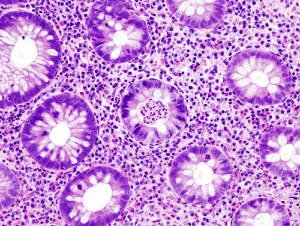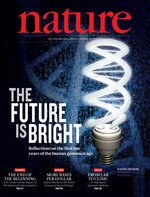Yes, it’s Friday Links time yet again here at Genomes Unzipped.
 A paper in Nature Genetics this week reports the results of a large meta-analysis of GWAS studies into ulcerative colitis, which more than doubles the number of loci known for the disease from 18 to 47. This pushes the proportion of heritability explained from 11 to 16%, and sheds more light on the shared and non-shared pathways between ulcerative colitis and Crohn’s disease, along with the interplay with other immune and inflammatory disorders.
A paper in Nature Genetics this week reports the results of a large meta-analysis of GWAS studies into ulcerative colitis, which more than doubles the number of loci known for the disease from 18 to 47. This pushes the proportion of heritability explained from 11 to 16%, and sheds more light on the shared and non-shared pathways between ulcerative colitis and Crohn’s disease, along with the interplay with other immune and inflammatory disorders.
The lead author is a Genomes Unzipped contributor, but he emphatically refused to contribute to this Friday Links post, on the grounds that he doesn’t want to blow his own trumpet. So, instead, here is a quote from the Sanger Institute’s press release:
“The genomic regions we have identified give us an insight into the biology underlying ulcerative colitis,” says Dr Carl Anderson, from the Wellcome Trust Sanger Institute and first author on the paper. “These important initial discoveries are the building blocks on which we can begin to derive better IBD treatments, though much further work is needed before these become a clinical reality.” [LJ]
 Nature has a special issue this week devoted to the decade of progress since the publication of the human genome sequence. Eric Lander, who was first author on the original Human Genome Project paper, has a long and thoughtful commentary on the subsequent impact of that publication across a wide range of fields. Elaine Mardis accompanies Lander’s piece with a discussion of the astonishing advances in sequencing technology over the last decade (including a figure that emphasises the tremendous impact of the development of the Solexa/Illumina Genome Analyzer platform, which boosted sequencing capacity by eight orders of magnitude in a single year!).
Nature has a special issue this week devoted to the decade of progress since the publication of the human genome sequence. Eric Lander, who was first author on the original Human Genome Project paper, has a long and thoughtful commentary on the subsequent impact of that publication across a wide range of fields. Elaine Mardis accompanies Lander’s piece with a discussion of the astonishing advances in sequencing technology over the last decade (including a figure that emphasises the tremendous impact of the development of the Solexa/Illumina Genome Analyzer platform, which boosted sequencing capacity by eight orders of magnitude in a single year!).
 The third major feature is the announcement of the National Human Genome Research Institute’s strategic plan for the development of genomic medicine (or “base pairs to bedside”, as they call it). This is a solid, overall sensible strategic plan, containing only a few surprises – we hope to be able to discuss it in a bit more depth next week. In the meantime, we’re hoping that clinicians aren’t too terrified by the prospect of genomic medicine as laid out in Figure 2 of the plan (left), which appears to consist of scrolling through large-font DNA sequence data on an iPad.
The third major feature is the announcement of the National Human Genome Research Institute’s strategic plan for the development of genomic medicine (or “base pairs to bedside”, as they call it). This is a solid, overall sensible strategic plan, containing only a few surprises – we hope to be able to discuss it in a bit more depth next week. In the meantime, we’re hoping that clinicians aren’t too terrified by the prospect of genomic medicine as laid out in Figure 2 of the plan (left), which appears to consist of scrolling through large-font DNA sequence data on an iPad.
There’s plenty more in the issue, but I was particularly pleased to see two of my favourite genomics writers – Misha Angrist and Kevin Davies – finally gracing the review pages of this august publication, although this reminded me that my own reviews of both books are long, long overdue… [DM]
A new site created by 23andMe community member Erica Joy – but unaffiliated with the company – provides an extremely useful list of third-party tools for analysing raw data from 23andMe that will be of interest to many of our readers. We plan to review a number of these tools and services over the coming months. [DM]
Ron Bailey has an entertaining piece over at Reason summarising the results of multiple recent studies suggesting that – contrary to the claims of many DTC genomics critics – receiving genetic risk information in a direct-to-consumer setting appears to have no serious negative consequences. He concludes that “[t]he only people who seem especially overwrought and unable to handle the results of genetic testing are bioethicists.” [DM]








 RSS
RSS Twitter
Twitter
0 Responses to “Ulcerative colitis genetics, Nature on the human genome”